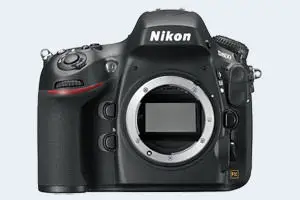Nikon D800 vs Pentax 645Z
The Nikon D800 and the Pentax 645Z are two professional cameras that were officially introduced, respectively, in February 2012 and April 2014. Both are DSLR (Digital Single Lens Reflex) cameras that are based on a full frame (D800) and a medium format (645Z) sensor. The Nikon has a resolution of 36.2 megapixels, whereas the Pentax provides 51.1 MP.
Below is an overview of the main specs of the two cameras as a starting point for the comparison.

Check D800 offers at
ebay.com

Check 645Z offers at
ebay.com
Going beyond this snapshot of core features and characteristics, what are the differences between the Nikon D800 and the Pentax 645Z? Which one should you buy? Read on to find out how these two cameras compare with respect to their body size, their imaging sensors, their shooting features, their input-output connections, and their reception by expert reviewers.
Body comparison
The side-by-side display below illustrates the physical size and weight of the Nikon D800 and the Pentax 645Z. The two cameras are presented according to their relative size. Three consecutive perspectives from the front, the top, and the back are available. All width, height and depth measures are rounded to the nearest millimeter.
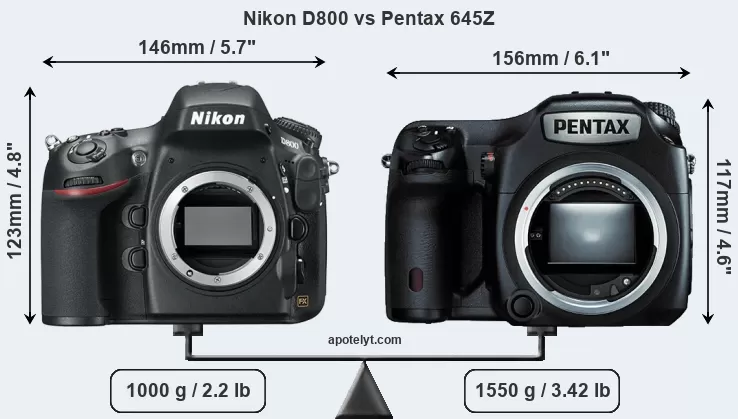
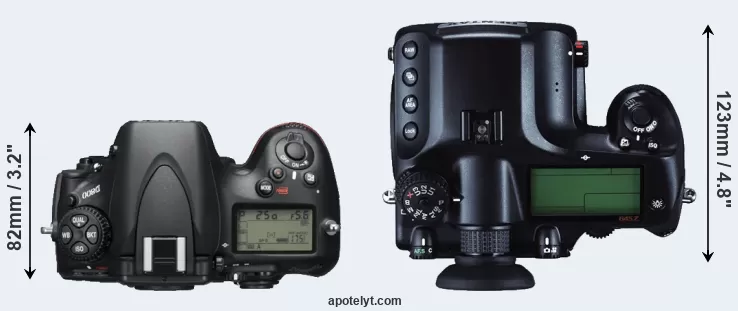
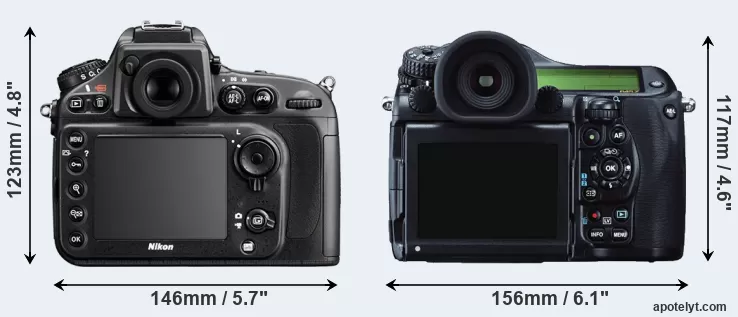
If the front view area (width x height) of the cameras is taken as an aggregate measure of their size, the Pentax 645Z is somewhat larger (2 percent) than the Nikon D800. Moreover, the 645Z is substantially heavier (55 percent) than the D800. In this context, it is worth noting that both cameras are splash and dust-proof and can, hence, be used in inclement weather conditions or harsh environments.
The above size and weight comparisons are to some extent incomplete since they do not consider the interchangeable lenses that both of these cameras require. Hence, you might want to study and compare the specifications of available lenses in order to get the full picture of the size and weight of the two camera systems.
Concerning battery life, the D800 gets 900 shots out of its Nikon EN-EL15 battery, while the 645Z can take 650 images on a single charge of its Pentax D-LI90 power pack.
The adjacent table lists the principal physical characteristics of the two cameras alongside a wider set of alternatives. In case you want to display and compare another camera duo, you can use the CAM-parator app to select your camera combination among a large number of options.

| Camera Model |
Camera Width |
Camera Height |
Camera Depth |
Camera Weight |
Battery Life |
Weather Sealing |
Camera Launch |
Launch Price |
Street Price |
||
|---|---|---|---|---|---|---|---|---|---|---|---|
| 1. | Nikon D800 | 146 mm | 123 mm | 82 mm | 1000 g | 900 | Y | Feb 2012 | US$ 2 999 | ebay.com | |
| 2. | Pentax 645Z | 156 mm | 117 mm | 123 mm | 1550 g | 650 | Y | Apr 2014 | US$ 8 499 | ebay.com | |
| 3. | Canon 5D Mark III | 152 mm | 116 mm | 76 mm | 950 g | 950 | Y | Mar 2012 | US$ 3 499 | ebay.com | |
| 4. | Canon 5D Mark IV | 151 mm | 116 mm | 76 mm | 890 g | 900 | Y | Aug 2016 | US$ 3 499 | amazon.com | |
| 5. | Canon 5DS | 152 mm | 116 mm | 76 mm | 930 g | 700 | Y | Feb 2015 | US$ 3 699 | ebay.com | |
| 6. | Canon 5DS R | 152 mm | 116 mm | 76 mm | 930 g | 700 | Y | Feb 2015 | US$ 3 699 | ebay.com | |
| 7. | Hasselblad X1D | 150 mm | 98 mm | 71 mm | 725 g | .. | Y | Jun 2016 | US$ 8 995 | ebay.com | |
| 8. | Leica SL | 147 mm | 104 mm | 39 mm | 847 g | 400 | Y | Oct 2015 | US$ 7 449 | ebay.com | |
| 9. | Nikon D4 | 160 mm | 157 mm | 91 mm | 1340 g | 2600 | Y | Jan 2012 | US$ 5 999 | ebay.com | |
| 10. | Nikon D600 | 141 mm | 113 mm | 82 mm | 850 g | 900 | Y | Sep 2012 | US$ 2 099 | ebay.com | |
| 11. | Nikon D610 | 141 mm | 113 mm | 82 mm | 850 g | 900 | Y | Oct 2013 | US$ 1 999 | ebay.com | |
| 12. | Nikon D700 | 147 mm | 123 mm | 77 mm | 1074 g | 1000 | Y | Jul 2008 | US$ 2 999 | ebay.com | |
| 13. | Nikon D800E | 146 mm | 123 mm | 82 mm | 1000 g | 900 | Y | Feb 2012 | US$ 3 299 | ebay.com | |
| 14. | Nikon D810 | 146 mm | 123 mm | 82 mm | 980 g | 1200 | Y | Jun 2014 | US$ 3 299 | ebay.com | |
| 15. | Nikon D850 | 146 mm | 124 mm | 79 mm | 1005 g | 1840 | Y | Jul 2017 | US$ 3 299 | amazon.com | |
| 16. | Nikon Df | 144 mm | 110 mm | 67 mm | 760 g | 1400 | Y | Nov 2013 | US$ 2 749 | ebay.com | |
| 17. | Pentax 645D | 156 mm | 117 mm | 119 mm | 1480 g | 800 | Y | Mar 2010 | US$ 9 995 | ebay.com | |
| Note: Measurements and pricing do not include easily detachable parts, such as add-on or interchangeable lenses or optional viewfinders. | |||||||||||
The price is, of course, an important factor in any camera decision. The listed launch prices provide an indication of the market segment that the manufacturer of the cameras have been targeting. The D800 was launched at a markedly lower price (by 65 percent) than the 645Z, which puts it into a different market segment. Usually, retail prices stay at first close to the launch price, but after several months, discounts become available. Later in the product cycle and, in particular, when the replacement model is about to appear, further discounting and stock clearance sales often push the camera price considerably down. Then, after the new model is out, very good deals can frequently be found on the pre-owned market.
Sensor comparison
The size of the sensor inside a digital camera is one of the key determinants of image quality. A large sensor will tend to have larger individual pixels that provide better low-light sensitivity, wider dynamic range, and richer color-depth than smaller pixel-units in a sensor of the same technological generation. Further, a large sensor camera will give the photographer additional creative options when using shallow depth-of-field to isolate a subject from its background. On the downside, larger sensors tend to be associated with larger, more expensive camera bodies and lenses.
Of the two cameras under consideration, the Nikon D800 features a full frame sensor and the Pentax 645Z a medium format sensor. The sensor area in the 645Z is 67 percent bigger. As a result of these sensor size differences, the cameras have a format factor of, respectively, 1.0 and 0.79. The sensor in the D800 has a native 3:2 aspect ratio, while the one in the 645Z offers a 4:3 aspect.
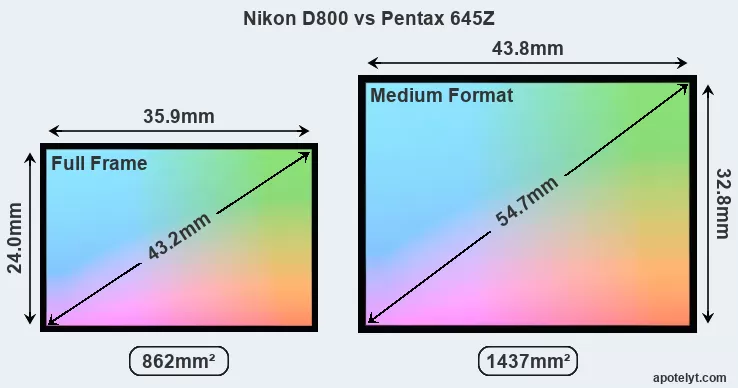
With 51.1MP, the 645Z offers a higher resolution than the D800 (36.2MP), but the 645Z nevertheless has larger individual pixels (pixel pitch of 5.30μm versus 4.88μm for the D800) due to its larger sensor. Moreover, the 645Z is a much more recent model (by 2 years and 2 months) than the D800, and its sensor will have benefitted from technological advances during this time that further enhance the light gathering capacity of its pixel-units. Coming back to sensor resolution, it should be mentioned that the 645Z has no anti-alias filter installed, so that it can capture all the detail its sensor resolves.
The resolution advantage of the Pentax 645Z implies greater flexibility for cropping images or the possibility to print larger pictures. The maximum print size of the 645Z for good quality output (200 dots per inch) amounts to 41.3 x 31 inches or 104.9 x 78.6 cm, for very good quality (250 dpi) 33 x 24.8 inches or 83.9 x 62.9 cm, and for excellent quality (300 dpi) 27.5 x 20.6 inches or 69.9 x 52.4 cm. The corresponding values for the Nikon D800 are 36.8 x 24.6 inches or 93.5 x 62.4 cm for good quality, 29.4 x 19.6 inches or 74.8 x 49.9 cm for very good quality, and 24.5 x 16.4 inches or 62.3 x 41.6 cm for excellent quality prints.
The Nikon D800 has a native sensitivity range from ISO 100 to ISO 6400, which can be extended to ISO 50-25600. The corresponding ISO settings for the Pentax 645Z are ISO 100 to ISO 204800 (no boost).
Technology-wise, both cameras are equipped with CMOS (Complementary Metal–Oxide–Semiconductor) sensors. Both cameras use a Bayer filter for capturing RGB colors on a square grid of photosensors. This arrangement is found in most digital cameras.
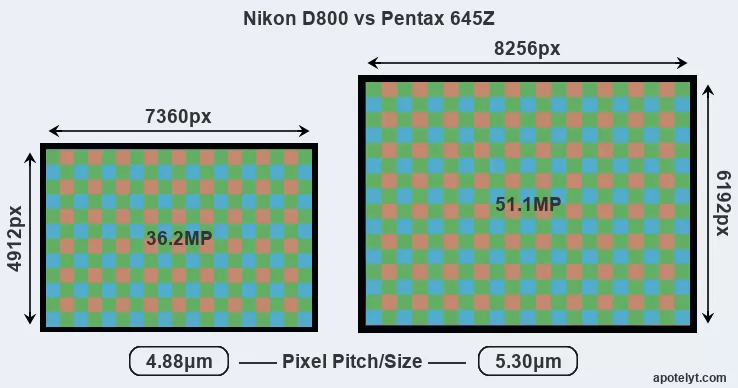
For many cameras, data on sensor performance has been reported by DXO Mark. This service is based on lab testing and assigns an overall score to each camera sensor, as well as ratings for dynamic range ("DXO Landscape"), color depth ("DXO Portrait"), and low-light sensitivity ("DXO Sports"). Of the two cameras under consideration, the 645Z has a markedly higher DXO score than the D800 (overall score 6 points higher), which will translate into better image quality. The advantage is based on 0.7 bits higher color depth, 0.3 EV in additional dynamic range, and 0.7 stops in additional low light sensitivity. The adjacent table reports on the physical sensor characteristics and the outcomes of the DXO sensor quality tests for a sample of comparator-cameras.

| Camera Model |
Sensor Class |
Resolution (MP) |
Horiz. Pixels |
Vert. Pixels |
Video Format |
DXO Portrait |
DXO Landscape |
DXO Sports |
DXO Overall |
||
|---|---|---|---|---|---|---|---|---|---|---|---|
| 1. | Nikon D800 | Full Frame | 36.2 | 7360 | 4912 | 1080/30p | 25.3 | 14.4 | 2853 | 95 | |
| 2. | Pentax 645Z | Medium Format | 51.1 | 8256 | 6192 | 1080/60i | 26.0 | 14.7 | 4505 | 101 | |
| 3. | Canon 5D Mark III | Full Frame | 22.1 | 5760 | 3840 | 1080/30p | 24.0 | 11.7 | 2293 | 81 | |
| 4. | Canon 5D Mark IV | Full Frame | 30.1 | 6720 | 4480 | 4K/30p | 24.8 | 13.6 | 2995 | 91 | |
| 5. | Canon 5DS | Full Frame | 50.3 | 8688 | 5792 | 1080/30p | 24.7 | 12.4 | 2381 | 87 | |
| 6. | Canon 5DS R | Full Frame | 50.3 | 8688 | 5792 | 1080/30p | 24.6 | 12.4 | 2308 | 86 | |
| 7. | Hasselblad X1D | Medium Format | 51.3 | 8272 | 6200 | 1080/25p | 26.2 | 14.8 | 4489 | 102 | |
| 8. | Leica SL | Full Frame | 24.0 | 6000 | 4000 | 4K/30p | 25.0 | 13.4 | 1821 | 88 | |
| 9. | Nikon D4 | Full Frame | 16.2 | 4928 | 3280 | 1080/30p | 24.7 | 13.1 | 2965 | 89 | |
| 10. | Nikon D600 | Full Frame | 24.2 | 6016 | 4016 | 1080/30p | 25.1 | 14.2 | 2980 | 94 | |
| 11. | Nikon D610 | Full Frame | 24.2 | 6016 | 4016 | 1080/30p | 25.1 | 14.4 | 2925 | 94 | |
| 12. | Nikon D700 | Full Frame | 12.1 | 4256 | 2832 | none | 23.5 | 12.2 | 2303 | 80 | |
| 13. | Nikon D800E | Full Frame | 36.2 | 7360 | 4912 | 1080/30p | 25.6 | 14.3 | 2979 | 96 | |
| 14. | Nikon D810 | Full Frame | 36.2 | 7360 | 4912 | 1080/60p | 25.7 | 14.8 | 2853 | 97 | |
| 15. | Nikon D850 | Full Frame | 45.4 | 8256 | 5504 | 4K/30p | 26.4 | 14.8 | 2660 | 100 | |
| 16. | Nikon Df | Full Frame | 16.2 | 4928 | 3280 | none | 24.6 | 13.1 | 3279 | 89 | |
| 17. | Pentax 645D | Medium Format | 39.5 | 7264 | 5440 | none | 24.6 | 12.6 | 1262 | 82 |
Many modern cameras are not only capable of taking still images, but also of capturing video footage. Both cameras under consideration have a sensor with sufficiently fast read-out times for moving pictures, but the 645Z provides a faster frame rate than the D800. It can shoot movie footage at 1080/60i, while the Nikon is limited to 1080/30p.
Feature comparison
Apart from body and sensor, cameras can and do differ across a range of features. The D800 and the 645Z are similar in the sense that both have an optical viewfinder. The latter is useful for getting a clear image for framing even in brightly lit environments. The viewfinder in the D800 offers a wider field of view (100%) than the one in the 645Z (98%), so that a larger proportion of the captured image is visible in the finder. On the other hand, the viewfinder of the 645Z has a higher magnification (0.78x vs 0.70x), so that the size of the image transmitted appears closer to the size seen with the naked human eye. The following table reports on some other key feature differences and similarities of the Nikon D800, the Pentax 645Z, and comparable cameras.

| Camera Model |
Viewfinder (Type or 000 dots) |
Control Panel (yes/no) |
LCD Specifications (inch/000 dots) |
LCD Attach- ment |
Touch Screen (yes/no) |
Max Shutter Speed * |
Max Shutter Flaps * |
Built-in Flash (yes/no) |
Built-in Image Stab |
||
|---|---|---|---|---|---|---|---|---|---|---|---|
| 1. | Nikon D800 | optical | Y | 3.2 / 921 | fixed | n | 1/8000s | 4.0/s | Y | n | |
| 2. | Pentax 645Z | optical | Y | 3.2 / 1037 | tilting | n | 1/4000s | 3.0/s | n | n | |
| 3. | Canon 5D Mark III | optical | Y | 3.2 / 1040 | fixed | n | 1/8000s | 6.0/s | n | n | |
| 4. | Canon 5D Mark IV | optical | Y | 3.2 / 1620 | fixed | Y | 1/8000s | 7.0/s | n | n | |
| 5. | Canon 5DS | optical | Y | 3.2 / 1040 | fixed | n | 1/8000s | 5.0/s | n | n | |
| 6. | Canon 5DS R | optical | Y | 3.2 / 1040 | fixed | n | 1/8000s | 5.0/s | n | n | |
| 7. | Hasselblad X1D | 2360 | n | 3.0 / 920 | fixed | Y | 1/2000s | 2.3/s | n | n | |
| 8. | Leica SL | 4400 | Y | 3.0 / 1040 | fixed | Y | 1/8000s | 11.0/s | n | n | |
| 9. | Nikon D4 | optical | Y | 3.2 / 921 | fixed | n | 1/8000s | 11.0/s | n | n | |
| 10. | Nikon D600 | optical | Y | 3.0 / 921 | fixed | n | 1/4000s | 5.5/s | Y | n | |
| 11. | Nikon D610 | optical | Y | 3.2 / 921 | fixed | n | 1/4000s | 6.0/s | Y | n | |
| 12. | Nikon D700 | optical | Y | 3.0 / 922 | fixed | n | 1/8000s | 8.0/s | Y | n | |
| 13. | Nikon D800E | optical | Y | 3.2 / 921 | fixed | n | 1/8000s | 4.0/s | Y | n | |
| 14. | Nikon D810 | optical | Y | 3.2 / 1229 | fixed | n | 1/8000s | 5.0/s | Y | n | |
| 15. | Nikon D850 | optical | Y | 3.2 / 2359 | tilting | Y | 1/8000s | 9.0/s | n | n | |
| 16. | Nikon Df | optical | Y | 3.2 / 921 | fixed | n | 1/4000s | 5.5/s | n | n | |
| 17. | Pentax 645D | optical | Y | 3.0 / 921 | fixed | n | 1/4000s | 1.1/s | n | n | |
| Note: *) Information refers to the mechanical shutter, unless the camera only has an electronic one. | |||||||||||
One difference between the cameras concerns the presence of an on-board flash. The D800 has one, while the 645Z does not. While the built-in flash of the D800 is not very powerful, it can at times be useful as a fill-in light.
The Nikon D800 and the Pentax 645Z both have an intervalometer built-in. This enables the photographer to capture time lapse sequences, such as flower blooming, a sunset or moon rise, without purchasing an external camera trigger and related software.
The D800 writes its imaging data to Compact Flash or SDXC cards, while the 645Z uses SDXC cards. Both cameras feature dual card slots, which can be very useful in case a memory card fails. Both cameras can use UHS-I cards, which provide for Ultra High Speed data transfer of up to 104 MB/s.
Connectivity comparison
For some imaging applications, the extent to which a camera can communicate with its environment can be an important aspect in the camera decision process. The table below provides an overview of the connectivity of the Nikon D800 and Pentax 645Z and, in particular, the interfaces the cameras (and selected comparators) provide for accessory control and data transfer.

| Camera Model |
Hotshoe Port |
Internal Mic / Speaker |
Microphone Port |
Headphone Port |
HDMI Port |
USB Port |
WiFi Support |
NFC Support |
Bluetooth Support |
||
|---|---|---|---|---|---|---|---|---|---|---|---|
| 1. | Nikon D800 | Y | mono / mono | Y | Y | mini | 3.0 | - | - | - | |
| 2. | Pentax 645Z | Y | stereo / mono | Y | - | mini | 3.0 | - | - | - | |
| 3. | Canon 5D Mark III | Y | mono / mono | Y | Y | mini | 2.0 | - | - | - | |
| 4. | Canon 5D Mark IV | Y | mono / mono | Y | Y | mini | 3.0 | Y | Y | - | |
| 5. | Canon 5DS | Y | mono / mono | Y | - | mini | 3.0 | - | - | - | |
| 6. | Canon 5DS R | Y | mono / mono | Y | - | mini | 3.0 | - | - | - | |
| 7. | Hasselblad X1D | Y | stereo / mono | Y | Y | mini | 3.0 | Y | - | - | |
| 8. | Leica SL | Y | stereo / mono | Y | Y | full | 3.0 | Y | - | - | |
| 9. | Nikon D4 | Y | mono / mono | Y | Y | micro | 2.0 | - | - | - | |
| 10. | Nikon D600 | Y | mono / mono | Y | Y | mini | 2.0 | - | - | - | |
| 11. | Nikon D610 | Y | mono / mono | Y | Y | mini | 2.0 | - | - | - | |
| 12. | Nikon D700 | Y | - / - | - | - | mini | 2.0 | - | - | - | |
| 13. | Nikon D800E | Y | mono / mono | Y | Y | mini | 3.0 | - | - | - | |
| 14. | Nikon D810 | Y | stereo / mono | Y | Y | mini | 3.0 | Y | - | - | |
| 15. | Nikon D850 | Y | stereo / mono | Y | Y | mini | 3.0 | Y | Y | Y | |
| 16. | Nikon Df | Y | - / - | - | - | mini | 2.0 | - | - | - | |
| 17. | Pentax 645D | Y | stereo / - | - | - | - | 2.0 | - | - | - |
It is notable that the D800 has a headphone jack, which is not present on the 645Z This port makes it possible to attach external headphones and monitor the quality of sound during the recording process.
Both cameras feature a PC Sync terminal to control professional strobe lights, which will be appreciated by studio photographers.
Both the D800 and the 645Z have been discontinued, but can regularly be found used on ebay. The D800 was replaced by the Nikon D810, while the 645Z does not have a direct successor. Further information on the features and operation of the D800 and 645Z can be found, respectively, in the Nikon D800 Manual (free pdf) or the online Pentax 645Z Manual.
Review summary
So how do things add up? Which of the two cameras – the Nikon D800 or the Pentax 645Z – has the upper hand? Is one clearly better than the other? Below is a summary of the relative strengths of each of the two contestants.

Reasons to prefer the Nikon D800:
- Better moiré control: Has an anti-alias filter to avoid artificial patterns to appear in images.
- Better sound control: Has a headphone port that enables audio monitoring while recording.
- More complete view: Has a viewfinder with a larger field of view (100% vs 98%).
- Faster shutter: Has higher mechanical shutter speed (1/8000s vs 1/4000s) to freeze action.
- Faster burst: Shoots at higher frequency (4 vs 3 flaps/sec) to capture the decisive moment.
- Less heavy: Is lighter (by 550g or 35 percent) and hence easier to carry around.
- Longer lasting: Can take more shots (900 versus 650) on a single battery charge.
- Easier fill-in: Is equipped with a small onboard flash to brighten deep shadow areas.
- More affordable: Was introduced into a lower priced category (65 percent cheaper at launch).
- More heavily discounted: Has been available for much longer (launched in February 2012).

Arguments in favor of the Pentax 645Z:
- More detail: Has more megapixels (51.1 vs 36.2MP), which boosts linear resolution by 17%.
- Maximized detail: Lacks an anti-alias filter to exploit the sensor's full resolution potential.
- Better image quality: Scores markedly higher (6 points) in the DXO overall evaluation.
- Better low-light sensitivity: Can shoot in dim conditions (0.7 stops ISO advantage).
- Better video: Provides higher movie framerates (1080/60i versus 1080/30p).
- Larger viewfinder image: Features a viewfinder with a higher magnification (0.78x vs 0.70x).
- More detailed LCD: Has a higher resolution rear screen (1037k vs 921k dots).
- More flexible LCD: Has a tilting screen for odd-angle shots in landscape orientation.
- More modern: Reflects 2 years and 2 months of technical progress since the D800 launch.
If the number of relative strengths (bullet points above) is taken as a guide, the D800 comes out slightly ahead of the 645Z (10 : 9 points). However, the relative importance of the various individual camera aspects will vary according to personal preferences and needs, so that you might like to apply corresponding weights to the particular features before making a decision on a new camera. A professional sports photographer will view the differences between cameras in a way that diverges from the perspective of a street photog, and a person interested in family portraits has distinct needs from a landscape shooter. Hence, the decision which camera is best and worth buying is often a very personal one.
How about other alternatives? Do the specifications of the Nikon D800 and the Pentax 645Z place the cameras among the top in their class? Find out in the latest Best DSLR Camera listing whether the two cameras rank among the cream of the crop.
In any case, while the comparison of the spec-sheets of cameras can offer a general idea of their imaging potential, it remains incomplete and does no justice, for example, to the way the D800 or the 645Z perform in practice. User reviews, such as those found at amazon, can sometimes inform about these issues, but such feedback is often incomplete, inconsistent, and biased.
Expert reviews
This is where reviews by experts come in. The table below provides a synthesis of the camera assessments of some of the best known photo-gear review sites (amateurphotographer [AP], cameralabs [CL], digitalcameraworld [DCW], dpreview [DPR], ephotozine [EPZ], photographyblog [PB]). As can be seen, the professional reviewers agree in many cases on the quality of different cameras, but sometimes their assessments diverge, reinforcing the earlier point that a camera decision is often a very personal choice.

| Camera Model |
AP score |
CL score |
DCW score |
DPR score |
EPZ score |
PB score |
Camera Launch |
Launch Price |
Street Price |
||
|---|---|---|---|---|---|---|---|---|---|---|---|
| 1. | Nikon D800 | 5/5 | + + | .. | 82/100 | 5/5 | 5/5 | Feb 2012 | US$ 2 999 | ebay.com | |
| 2. | Pentax 645Z | 5/5 | .. | 3.5/5 | .. | 4.5/5 | 5/5 | Apr 2014 | US$ 8 499 | ebay.com | |
| 3. | Canon 5D Mark III | .. | + + | .. | 82/100 | 4.5/5 | 4.5/5 | Mar 2012 | US$ 3 499 | ebay.com | |
| 4. | Canon 5D Mark IV | 4.5/5 | + + | 4/5 | 87/100 | 4.5/5 | 4.5/5 | Aug 2016 | US$ 3 499 | amazon.com | |
| 5. | Canon 5DS | .. | + | .. | 83/100 | 4.5/5 | 4.5/5 | Feb 2015 | US$ 3 699 | ebay.com | |
| 6. | Canon 5DS R | 5/5 | + | .. | 83/100 | 5/5 | 4.5/5 | Feb 2015 | US$ 3 699 | ebay.com | |
| 7. | Hasselblad X1D | .. | o | .. | 81/100 | .. | 4/5 | Jun 2016 | US$ 8 995 | ebay.com | |
| 8. | Leica SL | 4/5 | .. | 4/5 | 84/100 | 4.5/5 | 4/5 | Oct 2015 | US$ 7 449 | ebay.com | |
| 9. | Nikon D4 | .. | .. | .. | .. | 4.5/5 | 4.5/5 | Jan 2012 | US$ 5 999 | ebay.com | |
| 10. | Nikon D600 | 4/5 | + + | .. | 87/100 | 5/5 | 4.5/5 | Sep 2012 | US$ 2 099 | ebay.com | |
| 11. | Nikon D610 | 4/5 | + + | .. | 87/100 | 4.5/5 | 4.5/5 | Oct 2013 | US$ 1 999 | ebay.com | |
| 12. | Nikon D700 | .. | 89/100 | .. | + + | 4.5/5 | 4.5/5 | Jul 2008 | US$ 2 999 | ebay.com | |
| 13. | Nikon D800E | .. | .. | .. | 84/100 | 5/5 | 5/5 | Feb 2012 | US$ 3 299 | ebay.com | |
| 14. | Nikon D810 | 5/5 | .. | 5/5 | 86/100 | 5/5 | 4.5/5 | Jun 2014 | US$ 3 299 | ebay.com | |
| 15. | Nikon D850 | 4.5/5 | + + | 5/5 | 89/100 | 4.5/5 | 5/5 | Jul 2017 | US$ 3 299 | amazon.com | |
| 16. | Nikon Df | 4/5 | .. | .. | 81/100 | 4/5 | 4/5 | Nov 2013 | US$ 2 749 | ebay.com | |
| 17. | Pentax 645D | 5/5 | .. | .. | .. | .. | .. | Mar 2010 | US$ 9 995 | ebay.com | |
| Note: (+ +) highly recommended; (+) recommended; (o) reviewed; (..) not available. | |||||||||||
Care should be taken when interpreting the review scores above, though. The assessments were made in relation to similar cameras of the same technological generation. Hence, a score should always be seen in the context of the camera's market launch date and its price, and comparisons of ratings among very different cameras or across long time periods have little meaning. Also, please note that some of the review sites have changed their methodology and reporting over time.

Check D800 offers at
ebay.com

Check 645Z offers at
ebay.com
Other camera comparisons
Did this review help to inform your camera decision process? In case you are interested in seeing how other cameras pair up, just make a corresponding selection in the search boxes below. There is also a set of direct links to comparison reviews that other users of the CAM-parator app explored.
- Fujifilm GFX 50S vs Nikon D800
- Fujifilm X-Pro1 vs Nikon D800
- Nikon 1 V1 vs Pentax 645Z
- Nikon D800 vs Olympus PEN-F
- Nikon D800 vs Panasonic GF1
- Nikon D800 vs Panasonic GX850
- Nikon D800 vs Sony A7S III
- Olympus E-M10 II vs Pentax 645Z
- Olympus TG-5 vs Pentax 645Z
- Panasonic G95 vs Pentax 645Z
- Panasonic S5 II vs Pentax 645Z
- Pentax 645Z vs Sony A6400
Specifications: Nikon D800 vs Pentax 645Z
Below is a side-by-side comparison of the specs of the two cameras to facilitate a quick review of their differences and common features.
| Camera Model | Nikon D800 | Pentax 645Z |
|---|---|---|
| Camera Type | Digital single lens reflex | Digital single lens reflex |
| Camera Lens | Nikon F mount lenses | Pentax 645 mount lenses |
| Launch Date | February 2012 | April 2014 |
| Launch Price | USD 2,999 | USD 8,499 |
| Sensor Specs | Nikon D800 | Pentax 645Z |
| Sensor Technology | CMOS | CMOS |
| Sensor Format | Full Frame Sensor | Medium Format Sensor |
| Sensor Size | 35.9 x 24.0 mm | 43.8 x 32.8 mm |
| Sensor Area | 861.6 mm2 | 1436.64 mm2 |
| Sensor Diagonal | 43.2 mm | 54.7 mm |
| Crop Factor | 1.0x | 0.79x |
| Sensor Resolution | 36.2 Megapixels | 51.1 Megapixels |
| Image Resolution | 7360 x 4912 pixels | 8256 x 6192 pixels |
| Pixel Pitch | 4.88 μm | 5.30 μm |
| Pixel Density | 4.20 MP/cm2 | 3.56 MP/cm2 |
| Moiré control | Anti-Alias filter | no AA filter |
| Movie Capability | 1080/30p Video | 1080/60i Video |
| ISO Setting | 100 - 6,400 ISO | 100 - 204,800 ISO |
| ISO Boost | 50 - 25,600 ISO | no Enhancement |
| Image Processor | EXPEED 3 | PRIME III |
| DXO Sensor Quality (score) | 95 | 101 |
| DXO Color Depth (bits) | 25.3 | 26.0 |
| DXO Dynamic Range (EV) | 14.4 | 14.7 |
| DXO Low Light (ISO) | 2853 | 4505 |
| Screen Specs | Nikon D800 | Pentax 645Z |
| Viewfinder Type | Optical viewfinder | Optical viewfinder |
| Viewfinder Field of View | 100% | 98% |
| Viewfinder Magnification | 0.70x | 0.78x |
| Top-Level Screen | Control Panel | Control Panel |
| LCD Framing | Live View | Live View |
| Rear LCD Size | 3.2inch | 3.2inch |
| LCD Resolution | 921k dots | 1037k dots |
| LCD Attachment | Fixed screen | Tilting screen |
| Shooting Specs | Nikon D800 | Pentax 645Z |
| Focus System | Phase-detect AF | Phase-detect AF |
| Manual Focusing Aid | no Peaking Feature | Focus Peaking |
| Max Shutter Speed (mechanical) | 1/8000s | 1/4000s |
| Continuous Shooting | 4 shutter flaps/s | 3 shutter flaps/s |
| Shutter Life Expectancy | 200 000 actuations | 100 000 actuations |
| Time-Lapse Photography | Intervalometer built-in | Intervalometer built-in |
| Fill Flash | Built-in Flash | no On-Board Flash |
| Storage Medium | CF or SDXC cards | SDXC cards |
| Single or Dual Card Slots | Dual card slots | Dual card slots |
| UHS card support | UHS-I | UHS-I |
| Connectivity Specs | Nikon D800 | Pentax 645Z |
| External Flash | Hotshoe | Hotshoe |
| Studio Flash | PC Sync socket | PC Sync socket |
| USB Connector | USB 3.0 | USB 3.0 |
| HDMI Port | mini HDMI | mini HDMI |
| Microphone Port | External MIC port | External MIC port |
| Headphone Socket | Headphone port | no Headphone port |
| Wifi Support | no Wifi | no Wifi |
| Body Specs | Nikon D800 | Pentax 645Z |
| Environmental Sealing | Weathersealed body | Weathersealed body |
| Battery Type | Nikon EN-EL15 | Pentax D-LI90 |
| Battery Life (CIPA) | 900 shots per charge | 650 shots per charge |
| Body Dimensions |
146 x 123 x 82 mm (5.7 x 4.8 x 3.2 in) |
156 x 117 x 123 mm (6.1 x 4.6 x 4.8 in) |
| Camera Weight | 1000 g (35.3 oz) | 1550 g (54.7 oz) |

Check D800 offers at
ebay.com

Check 645Z offers at
ebay.com
Did you notice an error on this page? If so, please get in touch, so that we can correct the information.
